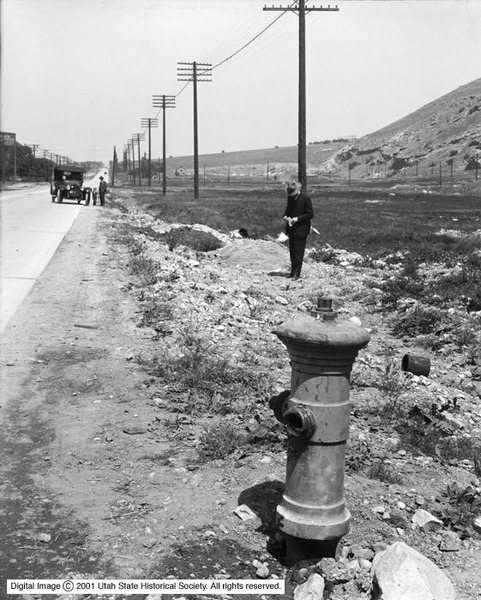Dublin Core
Title
Description
In the early 1900s, Utah’s towns invested heavily in civic improvements that used water for indoor plumbing, safe and convenient drinking, and firefighting. Due to changing demands of urban life, cities funded infrastructure -- such as street-side fire hydrants -- which improved public safety by preventing the spread of fires in homes and businesses. The path to modernization, however, was full of challenges as Utahns adapted to this new community resource.
Before hydrants, neighbors relied on “bucket brigades” to fight fires. Helpful hands passed along buckets of water in an attempt to extinguish fires and (hopefully) prevent the flames from spreading to surrounding buildings. Without immediate access to a public water supply, bucket brigades could be slow, allowing fires time to grow. Fire hydrants, however, provided quicker access to water that could douse fires and prevent entire communities from going up in flames.
Cities that invested in this type of waterworks were safer than those without. The northern Utah town of Corinne, for example, funded water infrastructure early, maintaining an efficient fire department and adequate water supply. Five hydrants throughout the town provided a pressured stream of water that could reach 120 feet to the top of any building. The investment paid off, and the town never suffered a major fire after the hydrants were installed.
Fire hydrants could save lives and property, but weren’t without issues. Initially, there was little understanding among community members about how to work the hydrants. In 1915, a fire broke out at the New York Store in the town of Beaver. The owner attempted to put out the flames and several neighbors came to help. Unfortunately, they did not know how to operate the fire hydrants. Their confusion lost precious time and when firefighters arrived on the scene, the building and its merchandise were completely destroyed.
Such growing pains didn’t slow the demand for more fire hydrants, however, and outfitting Utah towns with this kind of infrastructure was a community effort. Amassing the expensive equipment was considered a public duty that business owners, civic groups, and city councils worked together to fund. Fire hydrants offered critical access to water that could save lives and livelihoods in growing cities.
Creator
Source
_______________
See Martha Sontag Bradley, A History of Beaver County, Salt Lake City: Utah State Historical Society, 1999; “$4,000 Fire on Main Street,” Beaver Press, July 9, 1915; Jessie L. Embry, “A Tiny Ripple: The Growth of Heber City and the Wasatch Wave, 1889-1920,” Utah Historical Quarterly (vol. 57, no. 3), Summer 1989; “The Women’s Literary Club of Moab,” The History Blazer, Utah State Historical Society, May 1996.

